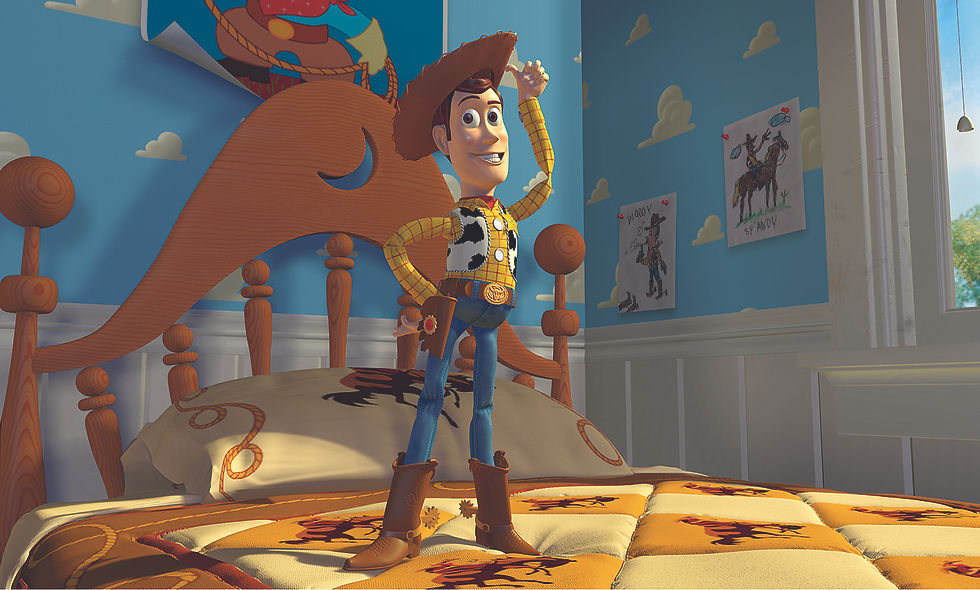Toy Story (1995)
- Soames Inscker

- Jul 13
- 3 min read

When Toy Story debuted in 1995, it not only captivated audiences — it revolutionized the entire landscape of animated cinema. As the first feature-length film created entirely with computer-generated imagery (CGI), Toy Story was groundbreaking. But its technical achievement is only one part of its legacy. At its core, the film is a timeless, emotionally rich, and delightfully entertaining story that appeals equally to children and adults.
Plot Summary
The story is set in a world where toys come to life when humans aren’t around. Woody (voiced by Tom Hanks), a pull-string cowboy doll, is the beloved leader of a group of toys that belong to a young boy named Andy. Life in the toy box is peaceful — until Andy receives a shiny new birthday present: Buzz Lightyear (voiced by Tim Allen), a flashy space ranger with gadgets, wings, and the mistaken belief that he is a real space hero.
Buzz’s arrival threatens Woody’s position as Andy’s favourite toy, sparking jealousy and conflict. After a series of mishaps and misunderstandings, Woody and Buzz find themselves lost in the outside world and must overcome their rivalry to make it back home. Along the way, they form an unlikely friendship and come to understand their true identities and value as toys.
Animation and Visual Innovation

Toy Story marked a monumental leap in animation. Pixar, under the leadership of John Lasseter and with backing from Disney, created a fully computer-animated feature at a time when hand-drawn animation still dominated. The result was a vibrant, three-dimensional world that dazzled with texture, depth, and realism never before seen in animated film.
From the reflective surfaces of Buzz’s plastic helmet to the stitched seams of Woody’s fabric shirt, the attention to detail was astonishing. The film’s visual style may appear simple compared to modern Pixar productions, but in 1995 it was revolutionary — and remains visually charming to this day.
Characters and Voice Performances

What truly elevates Toy Story is its characters, brought to life with warmth, humour, and humanity. Tom Hanks imbues Woody with a blend of charm, insecurity, and leadership, while Tim Allen’s Buzz Lightyear is both heroic and hilariously delusional. Their dynamic — rivalry evolving into camaraderie — is the emotional heart of the film.
The supporting cast adds rich comic flavor: Don Rickles as the wisecracking Mr. Potato Head, Wallace Shawn as the neurotic Rex the dinosaur, and Annie Potts as the gentle and caring Bo Peep. Each toy has a distinct personality, which makes the world of Toy Story feel fully alive and relatable.
Themes and Emotional Depth
At its heart, Toy Story is a story about friendship, identity, jealousy, and personal growth. Woody’s journey from resentment to understanding reflects a mature exploration of change, fear of obsolescence, and learning to share affection. Buzz’s arc — discovering he is not a real space ranger but still finding worth in being a toy — is a poignant metaphor for self-acceptance.
These deeper emotional threads are seamlessly woven into the humour and action, making the film resonate with viewers of all ages. It’s rare for a family film to combine laugh-out-loud moments with genuine emotional introspection, but Toy Story does so effortlessly.
Music and Score
Randy Newman’s iconic soundtrack is another essential component of the film’s charm. Songs like “You’ve Got a Friend in Me” became instantly memorable, underscoring the film’s themes of loyalty and friendship. Newman’s score strikes a perfect balance between playful and heartfelt, mirroring the emotional tone of the narrative.
Legacy and Cultural Impact
Toy Story was a box office and critical triumph, launching Pixar as a dominant force in animation and ushering in a new era of digital filmmaking. It received three Academy Award nominations (including Best Original Screenplay — a rare honour for an animated film) and won a Special Achievement Oscar for its pioneering computer animation.
The film’s success spawned three sequels, each acclaimed in its own right, expanding the characters and emotional scope of the franchise. More than just a technical milestone, Toy Story laid the foundation for Pixar’s unique brand of heartfelt, intelligent storytelling that continues to influence the industry today.
Conclusion
Toy Story is not just a children's film, or a technical novelty — it's a landmark in cinematic storytelling. With its engaging characters, heartfelt themes, groundbreaking animation, and enduring humour, it remains a film that resonates across generations. It taught audiences to look at toys — and storytelling — in an entirely new way.
Rating:
A timeless, trailblazing classic that blends innovation with heart. Pixar’s first outing is still one of its very best.




